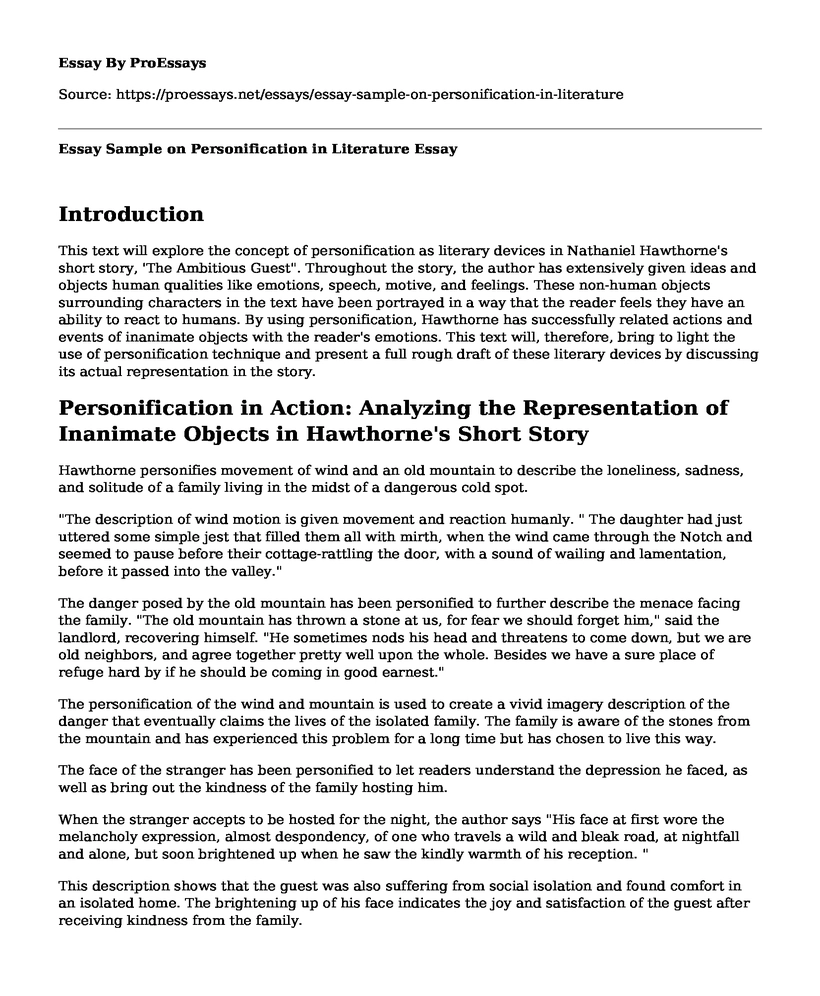Introduction
This text will explore the concept of personification as literary devices in Nathaniel Hawthorne's short story, 'The Ambitious Guest". Throughout the story, the author has extensively given ideas and objects human qualities like emotions, speech, motive, and feelings. These non-human objects surrounding characters in the text have been portrayed in a way that the reader feels they have an ability to react to humans. By using personification, Hawthorne has successfully related actions and events of inanimate objects with the reader's emotions. This text will, therefore, bring to light the use of personification technique and present a full rough draft of these literary devices by discussing its actual representation in the story.
Personification in Action: Analyzing the Representation of Inanimate Objects in Hawthorne's Short Story
Hawthorne personifies movement of wind and an old mountain to describe the loneliness, sadness, and solitude of a family living in the midst of a dangerous cold spot.
"The description of wind motion is given movement and reaction humanly. " The daughter had just uttered some simple jest that filled them all with mirth, when the wind came through the Notch and seemed to pause before their cottage-rattling the door, with a sound of wailing and lamentation, before it passed into the valley."
The danger posed by the old mountain has been personified to further describe the menace facing the family. "The old mountain has thrown a stone at us, for fear we should forget him," said the landlord, recovering himself. "He sometimes nods his head and threatens to come down, but we are old neighbors, and agree together pretty well upon the whole. Besides we have a sure place of refuge hard by if he should be coming in good earnest."
The personification of the wind and mountain is used to create a vivid imagery description of the danger that eventually claims the lives of the isolated family. The family is aware of the stones from the mountain and has experienced this problem for a long time but has chosen to live this way.
The face of the stranger has been personified to let readers understand the depression he faced, as well as bring out the kindness of the family hosting him.
When the stranger accepts to be hosted for the night, the author says "His face at first wore the melancholy expression, almost despondency, of one who travels a wild and bleak road, at nightfall and alone, but soon brightened up when he saw the kindly warmth of his reception. "
This description shows that the guest was also suffering from social isolation and found comfort in an isolated home. The brightening up of his face indicates the joy and satisfaction of the guest after receiving kindness from the family.
The author personifies the love that seemingly started developing between the despondent stranger and the eldest daughter in the isolated family.
"Perhaps a germ of love was springing in their hearts, so pure that it might blossom in Paradise since it could not be matured on earth; for women worship such gentle dignity as his; and the proud, contemplative, yet kindly soul is oftenest captivated by simplicity like hers."
Hawthorne shows that two souls in the middle of an isolated and dangerous environment can find peace and comfort through love. The two were both lost in an empty void where death found them happily attracted to each other.
Towards the end of the story, the author personifies the sad fate of the isolated family and the guest, who were all buried alive.
"Down came the whole side of the mountain, in a cataract of ruin. Just before it reached the house, the stream broke into two branches--shivered not a window there, but overwhelmed the whole vicinity, blocked up the road, and annihilated everything in its dreadful course. Long ere the thunder of the great Slide had ceased to roar among the mountains, the mortal agony had been endured, and the victims were at peace. Their bodies were never found".
The Emotional Impact of Personification: Unveiling the Significance of Humanly Attributes in "The Ambitious Guest"
By personifying the destruction caused by the mountain, the author takes readers on a roller coaster of emotion that makes it possible to relate to the character's experiences. This effect brings to life the effect caused by the mountain in an engaging and interesting way that appeals to readers.
Conclusion
The personification of non-human ideas and objects is a useful technique for appealing to reader's emotion. As seen in Hawthorne's short story, giving humanly attributes to the wind, mountain and love make the text not only engaging but also exciting to read. These objects and ideas appear like human characters and therefore fulfill the role of adding rich imagery to the text. This allows the audience to connect well with events surrounding the character and develop a subjective and robust relationship with the isolated family. By using this literary device, the author has allowed the creation of mental illustration within the mind of the reader that helps understand the meaning of the text.
Works Cited
Hawthorne, Nathaniel. "The Ambitious Guest" 1971. Retrieved from http://www.classicreader.com/book/187/1/ on 2nd March 2018.
Cite this page
Essay Sample on Personification in Literature. (2022, Apr 04). Retrieved from https://proessays.net/essays/essay-sample-on-personification-in-literature
If you are the original author of this essay and no longer wish to have it published on the ProEssays website, please click below to request its removal:
- Compare and Contrast Essay on Oedipus the King and Hamlet
- Literary Devices: Diction, Sonnet and Imagery Essay
- Formalist Analysis of Dry September By Faulkner William
- Major Roles of Settings in Worn Path and The Thing They Carried
- Paralysis in Dubliners and the Contributing Factors Essay Example
- Essay on King Arthur & the Romance of Prose: Legends & Love in Challenging Times
- Essay on Crazy English: The Most Important Language Despite Its Contradicting Vocabulary







